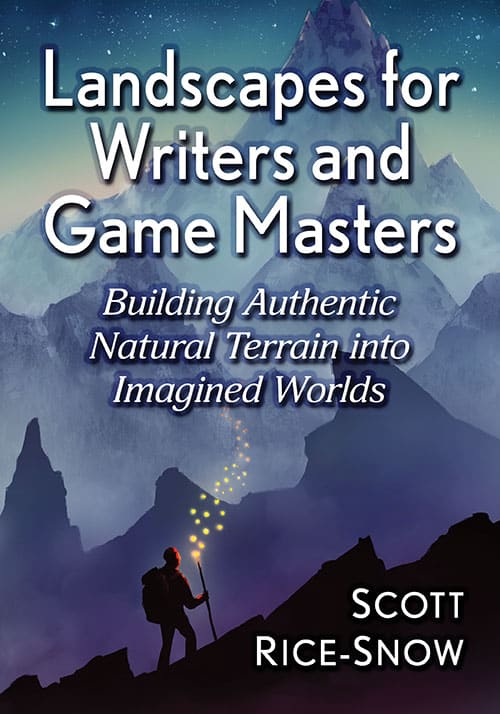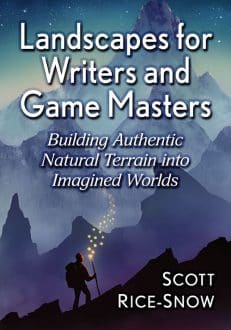Landscapes for Writers and Game Masters
Building Authentic Natural Terrain into Imagined Worlds
$25.00
In stock
About the Book
Landscape science tells fascinating stories, whether in fiction or a role-playing game. Earth’s varied terrain provides many examples of scene-specific challenges and resources for story characters, with distinctive land features, compelling locations, and intriguing traits. Landslides, floods, coastal erosion, glacier movement, and volcanism can deliver fresh plot points and alter the social character of an imagined region. Characters traveling different river types encounter very different puzzles, opportunities, and combat environments and the same variety awaits within other classic settings, such as caves, mountains, deserts, shorelines, and volcanic zones. Atypical landscapes such as tundra, karst, and vast glacier surfaces can breathe fresh air into any stories.
This handbook is a reference source for creative writing and game world building. It delves deeply into many landscape characteristics that help set the tone, shape character behavior, and drive the plot. Chapters are divided into diverse geographic environments, from rivers and shorelines to caves and volcanoes, and show how knowledge of the terrain can deliver plot points, add veracity, pose key problems, establish conflict, and lead into the next scene. Discover how authors and game masters effectively weave land and terrain into their stories.
About the Author(s)
Scott Rice-Snow is an emeritus professor of geological sciences at Ball State University in Muncie, Indiana, with published research in river, glacial, and karst geomorphology, as well as hydrology, geoarchaeology, and geoscience education. He also hosts the ground4inspiration.net website, documenting unique landscape features and their narrative/gameplay potential.
Bibliographic Details
Scott Rice-Snow
Format: softcover (7 x 10)
Pages: 250
Bibliographic Info: 152 photos, index
Copyright Date: 2022
pISBN: 978-1-4766-8357-7
eISBN: 978-1-4766-4504-9
Imprint: McFarland
Table of Contents
Preface 1
Introduction 3
Features of the Chapters 4
On Magic and Technology 5
1. Rivers 7
Stream Channels 8
Stream Valleys 10
Meandering Rivers 14
Braided Rivers 20
Other River Types 26
River Change 28
2. Deserts 32
Desert Terrain 32
Rain in the Desert 34
Streams in the Desert 36
Desert Hillslopes 43
Desert Rock Formations 47
Sand Dunes 50
3. Wooded Lowlands 56
Why Focus on the Woods? 56
Processes Shaping the Land 57
Navigating the Woods 59
Lasting Effects of Continental Ice Sheets 65
4. Mountains 73
The Shapes of Mountains 73
Active Mountain Landscapes 79
Where Glaciers Have Been 86
5. Glaciers 96
Glacier Types 96
Glacier Movement 100
On a Glacier’s Surface 102
Beneath the Ice 106
At the Ice Margin 109
6. Tundra 112
Permafrost 112
Flowing Soil 114
Upheaving Stones 117
7. Karst Landscapes 122
Sinkholes 122
Karren 127
Tall Karst 129
Water Flow in Karst 132
8. Caves 138
Layouts of Cavern Systems 139
Passage Types 146
Floor, Wall, and Ceiling Features 154
Cave Entrances 160
Cave Weather 164
9. Volcanic Landscapes 166
Types of Eruption 166
Land Features Created by Volcanism 171
As Volcanic Landscapes Age 176
Hydrothermal Activity 183
10. Shorelines 188
Beaches 188
Bedrock Shorelines 200
Other Shoreline Settings 207
11. Continent-Scale World Building 213
Mountains 213
Rivers 217
Lowlands 220
Deserts 222
Volcanic Areas 224
Shorelines 225
Ocean Islands 228
Landscape Regions and Character Backgrounds 230
Index 239
Book Reviews & Awards
“Invaluable an innovative resource for the novelist and the video game creator. Exceptionally well written, organize and presented…unique…recommended.”—Midwest Book Review





